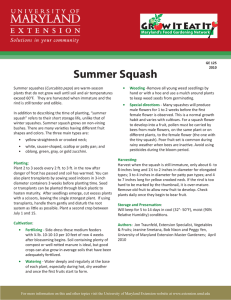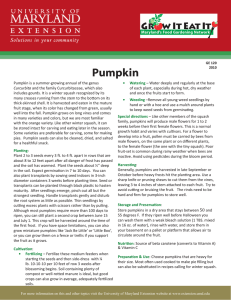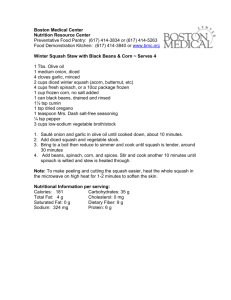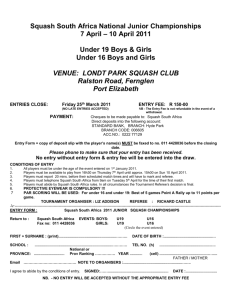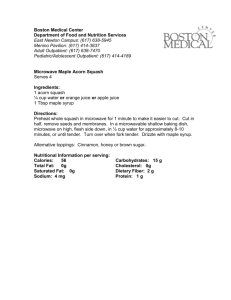Winter Squash
advertisement
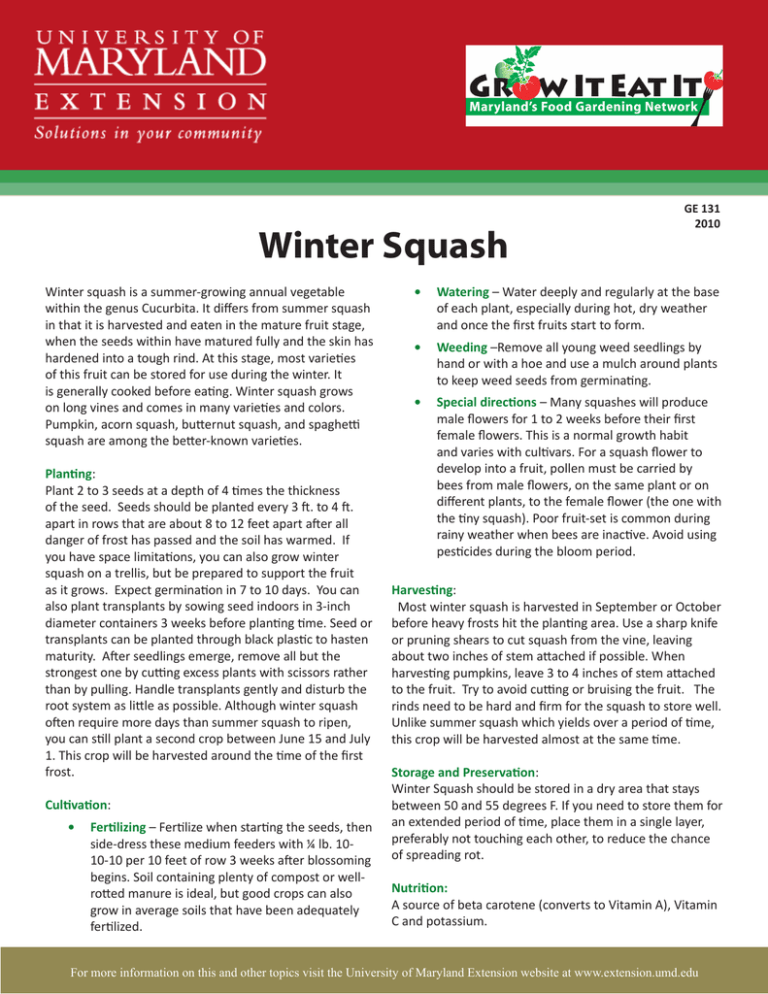
Winter Squash Winter squash is a summer-growing annual vegetable within the genus Cucurbita. It differs from summer squash in that it is harvested and eaten in the mature fruit stage, when the seeds within have matured fully and the skin has hardened into a tough rind. At this stage, most varieties of this fruit can be stored for use during the winter. It is generally cooked before eating. Winter squash grows on long vines and comes in many varieties and colors. Pumpkin, acorn squash, butternut squash, and spaghetti squash are among the better-known varieties. Planting: Plant 2 to 3 seeds at a depth of 4 times the thickness of the seed. Seeds should be planted every 3 ft. to 4 ft. apart in rows that are about 8 to 12 feet apart after all danger of frost has passed and the soil has warmed. If you have space limitations, you can also grow winter squash on a trellis, but be prepared to support the fruit as it grows. Expect germination in 7 to 10 days. You can also plant transplants by sowing seed indoors in 3-inch diameter containers 3 weeks before planting time. Seed or transplants can be planted through black plastic to hasten maturity. After seedlings emerge, remove all but the strongest one by cutting excess plants with scissors rather than by pulling. Handle transplants gently and disturb the root system as little as possible. Although winter squash often require more days than summer squash to ripen, you can still plant a second crop between June 15 and July 1. This crop will be harvested around the time of the first frost. Cultivation: • Fertilizing – Fertilize when starting the seeds, then side-dress these medium feeders with ¼ lb. 1010-10 per 10 feet of row 3 weeks after blossoming begins. Soil containing plenty of compost or wellrotted manure is ideal, but good crops can also grow in average soils that have been adequately fertilized. GE 131 2010 • Watering – Water deeply and regularly at the base of each plant, especially during hot, dry weather and once the first fruits start to form. • Weeding –Remove all young weed seedlings by hand or with a hoe and use a mulch around plants to keep weed seeds from germinating. • Special directions – Many squashes will produce male flowers for 1 to 2 weeks before their first female flowers. This is a normal growth habit and varies with cultivars. For a squash flower to develop into a fruit, pollen must be carried by bees from male flowers, on the same plant or on different plants, to the female flower (the one with the tiny squash). Poor fruit-set is common during rainy weather when bees are inactive. Avoid using pesticides during the bloom period. Harvesting: Most winter squash is harvested in September or October before heavy frosts hit the planting area. Use a sharp knife or pruning shears to cut squash from the vine, leaving about two inches of stem attached if possible. When harvesting pumpkins, leave 3 to 4 inches of stem attached to the fruit. Try to avoid cutting or bruising the fruit. The rinds need to be hard and firm for the squash to store well. Unlike summer squash which yields over a period of time, this crop will be harvested almost at the same time. Storage and Preservation: Winter Squash should be stored in a dry area that stays between 50 and 55 degrees F. If you need to store them for an extended period of time, place them in a single layer, preferably not touching each other, to reduce the chance of spreading rot. Nutrition: A source of beta carotene (converts to Vitamin A), Vitamin C and potassium. For more information on this and other topics visit the University of Maryland Extension website at www.extension.umd.edu Preparation & Use: Cut into halves and bake or peel and cut into pieces to bake, steam, or microwave. Can also be mashed or pureed. Authors: Jon Traunfeld, Extension Specialist, Vegetables & Fruits; Jeanine Smetana, Bob Nixon, and Peggy Yen, University of Maryland Extension Master Gardeners May 2010 Do you have a plant or insect pest question? Visit us at extension.umd.edu/hgic and click Ask Maryland’s Garden Experts Author: Jon Traunfeld, University of Maryland Extension Specialist, Home and Garden Information Center, Vegetables & Fruits; Jeanine Smetana, Bob Nixon, and Peggy Yen, University of Maryland Extension Master Gardeners This publication, GE131, is a series of publications of the University of Maryland Extension and The Home and Garden Information Center. For more information on related publications and programs, http://extension.umd.edu/hgic. Please visit http://extension.umd.edu/ to find out more about Extension programs in Maryland. The University of Maryland, College of Agriculture and Natural Resources programs are open to all and will not discriminate against anyone because of race, age, sex, color, sexual orientation, physical or mental disability, religion, ancestry, or national origin, marital status, genetic information, or political affiliation, or gender identity and expression. 2 For more information on this and other topics visit the University of Maryland Extension website at www.extension.umd.edu
